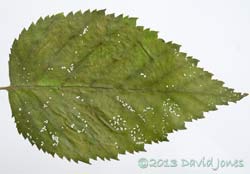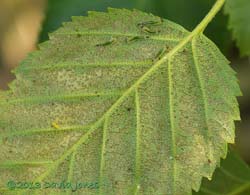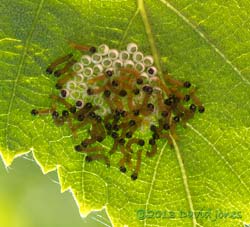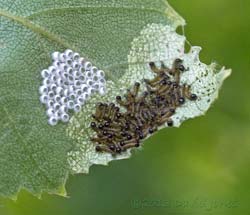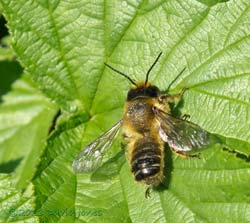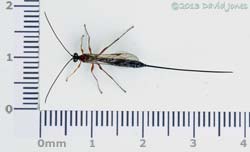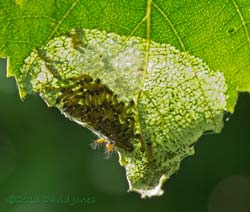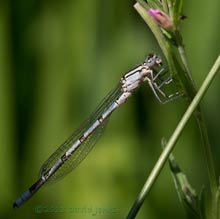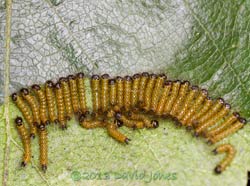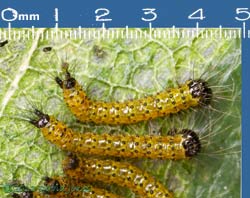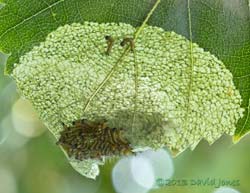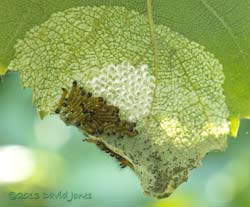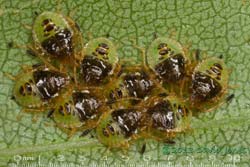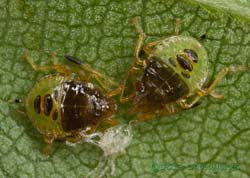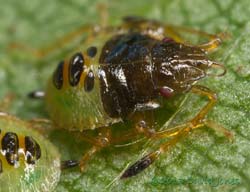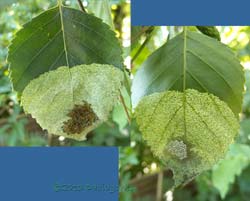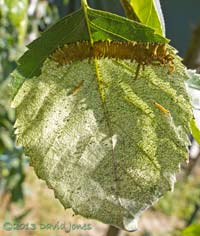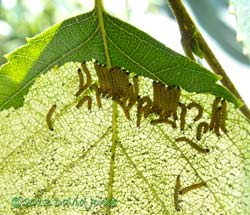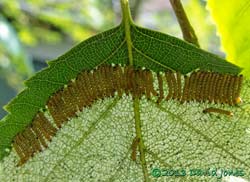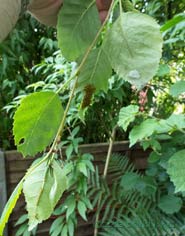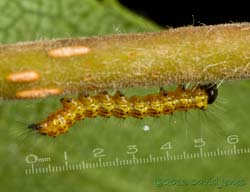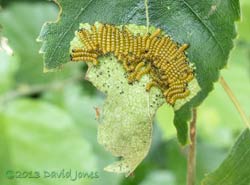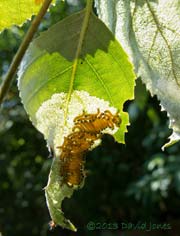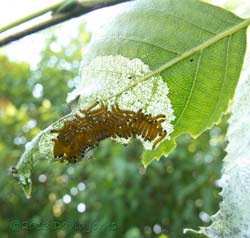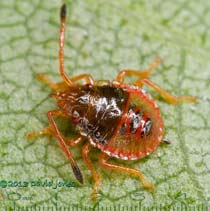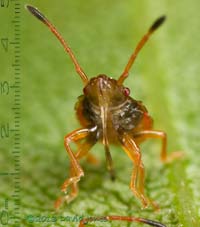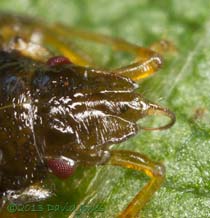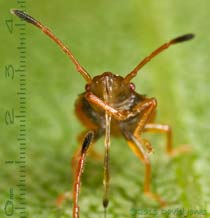Go to the last entry on this page .....Go to previous entry7 July - The temperature creeps upwards - Yesterday 26C and today Farnborough registered 28C over a period of over four hours during the afternoon. In the garden we had a large shelter up over our grandson's play area and under it a thermometer registered 34C for an hour or so!
The leaf looks rather wrinkly, but that is because I didn't photograph it immediately after releasing the larvae. It dried and curled up in the heat of the morning and I needed to soak and then press it before taking the picture!
On the Birch other leaves are supporting similar larvae and this picture one which has five larvae, each measuring at least 6mm - the leaf has sustained a great deal of damage.
Just about every time I take a look at the tree I spot something else that is making use of it. In this case I seem to have missed a cluster of eggs only to spot them as the last of a large group of caterpillars hatched out from them around 8am this morning.
At 6.45pm the group were clustered together in the same spot under the leaf, having eaten quite a bit of tissue from the upper surface of the leaf apex.
A bit of time spent searching online this morning solved another one of my birch tree puzzles in a way that surprised me. What I thought must have been pupal cases made out of leaves that had been cut and curled are most likely nurseries created by the Birch Leaf Roller (Deporaus betulae). This is a small weevil, about 5mm long and the female cuts most of the way across a leaf to produce the cone that I see, and in which she lays an egg. This morning I removed one of the cones from the tree and opened it up. The leaf had been wrapped around very tightly and in the middle was a larva around 2-3mm long. Unfortunately I wasn't able to take any pictures at that time, but I will try again when I see other cones appear.. also I shall have to watch out for the adults, and hopefully catch one in the act of cutting a leaf.
I saw our first leaf-cutter bee of the year this morning, sunning itself, and although it was disturbed by me it soon returned to the same spot. Later in the day I saw one go into a hole in one of our bee hotels.
Finally, a 'catch' from last night. This Ichneumon fly was in our hallway and I released it this morning.
8 July - The sunny interlude continues - not a cloud to be seen and 22C in a pleasant breeze at 9.50am. In a few moments while our grandson takes a break from his energetic pursuits I've grabbed a couple of pictures with my Canon G12 rather than its big cousin.
The caterpillars fed overnight and while most have rejoined the 'huddle', the back-lighting supplied my the morning sunshine casts shadows on some that have remained on the upper surface of the leaf. Later, if I get the chance I'll take a higher resolution photograph to record the caterpillars in more detail.
On my way back to the house this damselfly caught my attention as it fluttered between the tall grasses that tower above the pond. This picture was taken when it settled briefly on a Willowherb.
Getting back to the caterpillars, I've needed to correct my earlier entries about them - they were eating the leaf from the upper surface, not its underside.
This afternoon I checked them to see how much leaf had been eaten during the morning, and this time I caught them (or at least, half of them) feeding on the upper surface of the leaf. As the picture shows, it appeared to be a rather regimented affair - above them is pristine leaf surface as they moved from the apex towards the leaf stalk.
Here is a close-up of a couple of the caterpillars, just around 3.5mm long at the moment. When they are a bit bigger I'll get some more views of one to aid in their identification.
Having taken several high magnification shots I resorted to the G12 again. However, by the time I did this all but two of the caterpillars, disturbed by my activity, had retreated to the apex and clustered together. The shadow that you can see to the right of them marks the position on the lower leaf surface of the other half of the original group.
These had been resting, not feeding, and you can see the accumulation of droppings between them and the leaf apex. Above them are 59 egg cases. I've not been able to count the caterpillars beyond being able to sat that there were 26 on the upper surface when I photographed them this afternoon.
The bug nymphs that hatched out on 1/2 July and which have remained in a tight cluster ever since were just the same first thing this morning, apart from looking a little larger. However, by tonight things were very different - during the day they had gone through a moult and dispersed into smaller groups across the leaf.
Here, one of the nymphs is still attached to its discarded skin. I'm now reasonably certain that they are the nymphs of the Green Shieldbug.
When it come to feeding these nymphs have a very different approach to the caterpillars recorded above in that they do not strip away layers of leaf with their jaws. Instead they use a joined beak, called a rostrum which acts like a hollow needle through which the shieldbug sucks sap out of the leaf.
Here you can see how the nymph is already equipped with at least a simple version of the rostrum. I wasn't able to photograph this on the first stage nymphs, but it would explain why there was no visible sign of damage to the leaf seen over the last week while they grew larger.
During the day the temperature reached 27C briefly, staying around 26C for most of the afternoon.
9 July - The very warm spell continues, although a pleasant east north-easterly breeze has kept it a bit cooler than yesterday, not getting to 26C until around 3pm. Our grandson kept us busy through the morning and we will be active again as soon as he wakes up from an early afternoon snooze. I forgot to mention in yesterday's entry that in the early evening a mature frog turned up on the bank of the big pond, and the little boy took great delight in watching it stalk and then eat several earthworms! This morning he spent time searching for more worms for the frog!
The picture were taken at 1.45pm, although the cluster, now entirely on the upper surface, looked unchanged from when I checked the leaf mid-morning. A careful look at the images confirmed that at least 57 caterpillars are present. Although I didn't catch them in the act, it's clear that feeding has occurred, the area affected now half the leaf area. It will be interesting to see how their group behaviour changes once the leaf has nothing more to offer.
10 July - Bright and sunny once more, although the very slow cooling trend is set to continue for a day or so longer. The temperature hovered at between 22 and 23C for most of the day, with 24C recorded briefly during the mid-morning and mid afternoon. It became quite cloudy for a while in the afternoon and there was a steady north-easterly breeze - an excellent drying day!
At 10.15am I managed to capture this feeding time as the caterpillars get close to running out of food on this leaf.
Once again, within moments of my touching the branch the party broke up and five minutes layer they were all back in a huddle at the leaf apex!
An hour later and they were feeding once more, and this time I was finally able to confirm a total of 57 caterpillars (55 in the picture and two out of shot, lower down the leaf).
By 3.15pm this army of caterpillars had complete that task and had left the leaf (top-right in the picture), heading down the drooping branch. Most had ended up as a cluster on the next leaf along, despite the fact that it had already been reduced to half its original size by a previous grazer. A small number had gone further along the branch to another leaf, but when I saw them a few seemed to be retracing their steps, heading back up the branch. Within the hour they had all rejoined the main cluster.
The movement of the caterpillars along the branch gave me an opportunity to photograph one in close-up and confirm the leg configuration of a caterpillar - 3 pairs of true legs, four pairs of prolegs and a pair of claspers at the rear. They have grown from around 3.5mm to 5.5mm in length in two days.
This morning I found eight pupae of the Harlequin Ladybird on the roses (Rosa rugosa) at the front of our house. Apart from these, I have seen no ladybirds in the garden so far this year, apart from a single 10-spot which appeared briefly back in May. I have at last caught up with the large images covering the last two pages of the diary!
11 July - The temperature only made it to 22C today, and at 8.30pm it was still 21C.
The caterpillar army appears to have had a relatively quiet day. Its members were feeding when I first looked just before 8am.
Having been out with one of our grand-daughters for most of the morning, the next time I checked on them was noon. By then they were back in what was a fairly organized huddle on the underside of the leaf, having eaten very little more during the morning.
And they were still there at 6pm.
The Shieldbug nymphs have presented me with a puzzle today. First of all, during the morning they were actively moving about the leaves that I had kept standing in water, so after I had taken my grand-daughter home I set about taking some photographs before releasing them back onto the Birch tree.
Since the 8th they have become much redder in colour and are now about 2.8mm long. This change in colour has me wondering about whether or not they are Green Shieldbugs!
In the previous set of pictures I was a bit flummoxed by the structure that poked out under the rear of their abdomens, but all was made clear today - it is the end of the rostrum. At the moment it is longer than the body.
I was also confused by the structure at the front of the body. The rostrum is a jointed structure, not flexible in the way this structure appears to be. It actually consists of the insect's mandible and maxillae . The very long pair of maxillae are linked together to create a food tube. This is partially enclosed by the two mandibles, the ends of which act as the piercing structures that create the opening through which the food tube can probe the leaf tissues.
The rostrum acts as a sheath to protect the feeding structure when it is not needed, and in this picture you can see the tube protruding from the end of the rostrum. Unfortunately I wasn't quick enough to pan the camera down to capture the whole structure!
And now the puzzle of the day. To release the shieldbug nymphs I picked three fresh Birch leaves, transferred the nymphs onto them, and then pegged these leaves to leaves attached to the tree. The intention being that the nymphs would find their way back onto the tree during the afternoon. Well, they did that and after two hours I was able to remove the pegs. Unfortunately, not only had all thirty nymphs found their way to freedom, but they had also all disappeared - completely! I searched all that part of the tree using a bright torch (it was still only 3pm, but I wanted to look into the shadows) and could not see a single nymph..... I have to wonder where the caterpillars will be tomorrow! Late News - I've just had another session with the torch, and I may have found at least some of the nymphs. There is a group looking suspiciously like the missing ones on a leaf about 12ft up and in a spot that would have been along a feasible route from the release point, although rather further away from it than I would have expected, but with no evidence of egg cases in the area. And while I looked I also found another set of newly emerged nymphs! And the caterpillars are still in exactly the same position, not having fed since this morning - are they preparing to moult?
Click on images to see larger versions
|
|
